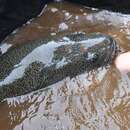Life Cycle
provided by Fishbase
Cod form pairs & only one male spawn with each female (Ref. 27498). The spawning site can be in water as shallow as 30 cm (Ref. 27498). The male protect and probably fans the eggs during incubation (Ref. 27498).Egg masses are laid on the bottom and adhere to the substrate (Ref. 6390).
- Recorder
- Crispina B. Binohlan
Migration
provided by Fishbase
Potamodromous. Migrating within streams, migratory in rivers, e.g. Saliminus, Moxostoma, Labeo. Migrations should be cyclical and predictable and cover more than 100 km.
- Recorder
- Crispina B. Binohlan
Trophic Strategy
provided by Fishbase
Murray cod are territorial, their 'territory' associated with a specific hole, snag (large woody debris) or area of a river or lake (Ref. 27498). Tagging studies have shown that most adult cod move less than 10 km, although there are records of fish moving more than 200 km (Ref. 27443). This movement is probably associated with breeding, although juveniles may undertake dispersal migrations.
Biology
provided by Fishbase
The Murray cod is one of the world's largest freshwater fish (Ref. 6390). They live in a wide range of habitats, from clear, rocky streams to slow flowing, turbid rivers and billabongs (Ref. 27498). They are generally found in waters to 5 m deep, in sheltered areas with cover from rocks, timber or overhanging banks. Adult fish are carnivorous, having a diet of invertebrates, fish, amphibians and occasionally reptiles, birds and aquatic mammals (Ref. 27498). The young feed on zooplankton. Spawning takes place from spring to early summer. Murray cod are territorial, their 'territory' associated with a specific hole, snag (large woody debris) or area of a river or lake (Ref. 27498). Juveniles may undertake migrations (Ref. 6390). Threatened due to over harvesting and habitat loss (Ref. 58490).
- Recorder
- Crispina B. Binohlan
Importance
provided by Fishbase
fisheries: commercial; aquaculture: commercial; gamefish: yes
- Recorder
- Crispina B. Binohlan

